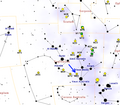Astronomy:Messier 69
| Messier 69 | |
|---|---|
| File:300px | |
| Observation data (J2000 epoch) | |
| Class | V[1] |
| Constellation | Sagittarius |
| Right ascension | 18h 31m 23.10s[2] |
| Declination | −32° 20′ 53.1″[2] |
| Distance | 29 kly (8.8 kpc)[3] |
| Apparent magnitude (V) | 7.6[4] |
| Apparent dimensions (V) | 10.8′[3] |
| Physical characteristics | |
| Mass | 2.0×105 M☉[5] M☉ |
| Radius | 45 ly[6] |
| Tidal radius | 91.9 ly.[3] |
| Metallicity | = –0.78[7] dex |
| Estimated age | 13.06 Gyr[7] |
| Other designations | GCl 96, M69, NGC 6637,[8]NGC 6634[9] |
Messier 69 or M69, also known NGC 6637, and NGC 6634,[9][10] is a globular cluster in the southern constellation of Sagittarius.[lower-alpha 1] It can be found 2.5° to the northeast of the star Epsilon Sagittarii and is dimly visible in 50 mm aperture binoculars. The cluster was discovered by Charles Messier on August 31, 1780, the same night he discovered M70. At the time, he was searching for an object described by Nicolas-Louis de Lacaille in 1751–2 and thought he had rediscovered it, but it is unclear if Lacaille actually described M69.[11]
This cluster is about 28,700[3] light-years away from Earth and 5,200 ly from the Galactic Center,[12] with a spatial radius of 45 light-years.[6] It is a relatively metal-rich globular cluster that is a likely member of the galactic bulge population.[13] It has a mass of 200000 M☉ with a half-mass radius of 11.6 ly,[5] a core radius of 29.2 ly, and a tidal radius of 91.9 ly.[3] Its center has a bright luminosity density of 6,460 L☉·pc−3 (meaning per cubic parsec).[12] It is a close neighbor of its analog M70 – possibly only 1,800 light-years separates the two.[14]
Gallery
-
As globular clusters go, M69 is one of the most metal-rich on record.[15]
-
Map showing location of M69
See also
References and footnotes
- ↑ Shapley, Harlow; Sawyer, Helen B. (August 1927), "A Classification of Globular Clusters", Harvard College Observatory Bulletin 849 (849): 11–14, Bibcode: 1927BHarO.849...11S.
- ↑ 2.0 2.1 Goldsbury, Ryan et al. (December 2010), "The ACS Survey of Galactic Globular Clusters. X. New Determinations of Centers for 65 Clusters", The Astronomical Journal 140 (6): 1830–1837, doi:10.1088/0004-6256/140/6/1830, Bibcode: 2010AJ....140.1830G.
- ↑ 3.0 3.1 3.2 3.3 3.4 Kharchenko, N. V. et al. (2013), "Global survey of star clusters in the Milky Way. II. The catalogue of basic parameters", Astronomy and Astrophysics 558: 8, doi:10.1051/0004-6361/201322302, A53, Bibcode: 2013A&A...558A..53K.
- ↑ "Messier 69". https://messier.seds.org/m/m069.html.
- ↑ 5.0 5.1 Mandushev, G. et al. (December 1991), "Dynamical masses for galactic globular clusters", Astronomy and Astrophysics 252: 94, Bibcode: 1991A&A...252...94M.
- ↑ 6.0 6.1 From trigonometry: distance × sin( diameter_angle / 2 ) = 28,700 × 0.00157 = 45 ly. radius
- ↑ 7.0 7.1 Forbes, Duncan A.; Bridges, Terry (May 2010), "Accreted versus in situ Milky Way globular clusters", Monthly Notices of the Royal Astronomical Society 404 (3): 1203–1214, doi:10.1111/j.1365-2966.2010.16373.x, Bibcode: 2010MNRAS.404.1203F.
- ↑ "NGC 6637". SIMBAD. Centre de données astronomiques de Strasbourg. http://simbad.u-strasbg.fr/simbad/sim-basic?Ident=NGC+6637.
- ↑ 9.0 9.1 "Your NED Search Results". https://ned.ipac.caltech.edu/cgi-bin/objsearch?objname=NGC+6634&extend=no&hconst=73&omegam=0.27&omegav=0.73&corr_z=1&out_csys=Equatorial&out_equinox=J2000.0&obj_sort=RA+or+Longitude&of=pre_text&zv_breaker=30000.0&list_limit=5&img_stamp=YES.
- ↑ "NGC/IC Project Restoration Efforts". https://ngcicproject.observers.org/NGC/NGC_66xx/NGC_6634.htm.
- ↑ Thompson, Robert Bruce; Thompson, Barbara Fritchman (2007), Illustrated Guide to Astronomical Wonders: From Novice to Master Observer, Maker Media, Inc., ISBN 978-1680451917, https://books.google.com/books?id=y24CCwAAQBAJ&pg=PT872
- ↑ 12.0 12.1 Piotto, G. et al. (September 2002), "HST color-magnitude diagrams of 74 galactic globular clusters in the HST F439W and F555W bands", Astronomy and Astrophysics 391 (3): 945–965, doi:10.1051/0004-6361:20020820, Bibcode: 2002A&A...391..945P.
- ↑ Heasley, J. N. et al. (August 2000), "Hubble Space Telescope Photometry of the Metal-rich Globular Clusters NGC 6624 and NGC 6637", The Astronomical Journal 120 (2): 879–893, doi:10.1086/301461, Bibcode: 2000AJ....120..879H.
- ↑ Frommert, Hartmut; Kronberg, Christine (July 20, 2011), "Globular Cluster M69", SEDS Messier pages (Students for the Exploration and Development of Space (SEDS)), http://messier.seds.org/m/m069.html, retrieved 2018-12-03.
- ↑ "Cosmic riches". ESA/Hubble Picture of the Week. https://www.spacetelescope.org/images/potw1240a/.
- ↑ In daily rising of this globular cluster, whether in day- or nighttime, it will reach 15° above the due southern horizon, at the 90°−32°−15° parallel thus the 43rd parallel north, the furthest north for very detailed, easy observation for this object
External links
- Messier 69, Galactic Globular Clusters Database page
- Messier 69 on WikiSky: DSS2, SDSS, GALEX, IRAS, Hydrogen α, X-Ray, Astrophoto, Sky Map, Articles and images
Coordinates: ![]() 18h 31m 23.23s, −32° 20′ 52.7″
18h 31m 23.23s, −32° 20′ 52.7″
 |
![As globular clusters go, M69 is one of the most metal-rich on record.[15]](/wiki/images/thumb/2/23/Messier_69_Hubble_WikiSky.jpg/120px-Messier_69_Hubble_WikiSky.jpg)


